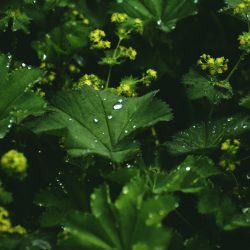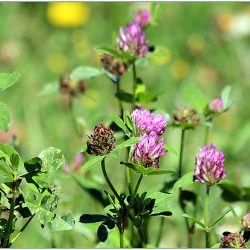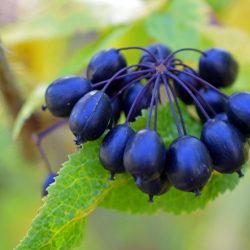If the hops were not approached medicinally speaking by the Ancients, it is because they probably did not yet know its qualities. Pliny mentions a hop used as a vegetable. In fact, the first achievement attributed to hops is not about medicine. It was customary, from the ninth century, in Germany, to use hops, especially in the manufacture of beer . Indeed, the addition of hops during the manufacturing process stabilizes the foam, ensures better conservation and gives a slight bitterness to the beer.
A little history
The first therapeutic indications for hops appear from the pen of Mésué , an Arab doctor. It indicates that the hops purge and clarify the blood.
At the time of Matthiole , hops really began their therapeutic career. The Florentine doctor said of the hops that it “evacuates the anger, and purges the blood of all its bilious and angry moods, deadening and extinguishing all the heat and inflammation”.
In 1554, Matthiole affirmed that, already, it would have been unthinkable to do without hops when making beer. Much better, it notably lays the first therapeutic bases concerning it: aperitif, depurative, laxative, detergent, dewormer, emmenagogue, so many properties that have been proven for a long time. The same goes for Dodoens , Lonitzer , Tabernaemontanus and, later, Bauhin and Lémery , the latter reaffirming the purifying properties of hops, its role in diseases of the liver and spleen, and finally its diuretic properties.
In the 18th century, Lieutaud confirmed the judgments of his predecessors. For him, hops nevertheless remain a good hepatic, aperitif, diuretic and depurative medicine. He even says it is suitable for fighting scurvy and administers it both externally (itching, sores, other skin diseases) and internally, and that for cases of hysteria and hypochondria, two conditions that will partially seal the therapeutic fate of hops . It was not until the beginning of the 19th century that we looked scientifically at the active principles of hops.
What are the main pharmacological properties of hop cones?
Estrogenic and anti-androgenic hormonal properties:
Studies measuring estrogenic activity measured in vitro on human endometrial cell lines have notably shown that estrogenic activity is essentially due to 8-prenylnaringenin (hopein), as well as to 6-prenylnaringenin and isoxanthohumol (not xanthohumol). The potent activity of 8-prenylnaringenin, the most estrogenic compound in hops, has been confirmed by several studies. It is reflected in its ability to bind competitively and equivalently to estrogen α and β receptors, with a relative binding affinity much stronger than that of two recognized phytoestrogens, coumestrol and genistein.
In women, this substance has demonstrated its activity in particular on climacteric disorders of menopause (hot flashes, vaginal dryness, mood and sleep disorders, etc.) in several randomized double-blind studies against placebo. .
8-prenylnaringenin would also be responsible for the anti-androgenic activity of hops. Furthermore, it inhibits angiogenesis in vitro and in vivo .
In vivo , the hydroalcoholic extract of hops decreases the number and motility of spermatozoa compared to the control group. It lowers testosterone and LH levels without affecting FSH levels.
Anti-osteoporotic properties:
A 2019 Chinese in vivo study demonstrated protective effects of a Humulus lupulus extract on bones by different mechanisms; on the one hand a significant increase in estradiol, cancellous bone structure , and bone mineral density , and on the other hand an equally significant reduction in serum alkaline phosphatase, tartrate-resistant acid phosphatase, Type I c-terminal telopeptides (CTX-I) and deoxypyridinoline level. In vitro, in comparison with a control group, the authors have thus shown that the hop extract promotes cell proliferation and increases the expression of the levels of bone morphogenic protein-2 and osteopontin in osteoblasts.
Another Chinese team showed, also in 2019, that the extraction, isolation, purification, structural identification and osteogenic activity of H. lupulus polysaccharides suggest a pronounced anti-osteoporotic activity attributed to the homogeneous polysaccharide HLP50- 2.
Action on the nervous system:
Hops therefore exert a sedative and hypnotic activity , attributed to the synergistic action. The sedative activity of hop extracts was therefore confirmed by an open multicenter study on 225 volunteers.
The efficacy of the combination of hops with valerian in the management of sleep disorders has been validated by several controlled studies, with a level of activity identical to that of benzodiazepines. In a randomized double-blind study, the combination of the two plants reduces the time it takes to fall asleep, while valerian alone is not enough.
Prenylflavonoid xanthohumol decreases Alzheimer- like changes in vitro and modulates multiple pathogenic molecular pathways in a cellular model of Alzheimer’s disease, suggesting that this substance may have potential for the treatment of this disease and / or neurodegenerative diseases of Alzheimer’s disease. neuropathological origin.
Bactericidal, bacteriostatic, antiviral and fungistatic action:
Due to cumulone and lupulone. These bitter compounds act on gram (+) and gram (-) bacteria in an inverse manner to their water solubility, which makes it possible to conclude that this bactericidal and bacteriostatic activity is located at the level of liposoluble membrane components.
In 2019, a French team demonstrated that the prenylated chalcones and acylphloroglucinols of Humulus lupulus exert a powerful antibacterial action on strains of Staphylococcus aureus resistant to methicillin, Leishmania mexicana and Trypanosoma brucei .
According to two studies, the polyphenols in hops slow down the development of dental plaque and could ultimately be of therapeutic interest in the management of periodontal disease . The mechanism of action involves the suppression of the production of water-insoluble glucan induced by S treptococcus mutans , one of the main periodontal germs.
The hydroalcoholic extract obtained from female inflorescences of humulus lupulus exerts in vitro an antiviral activity of the anti-influenza type, and also shows antioxidant properties .
In vitro , hop extracts are also fungistatic.
Other properties:
- Anti- cancer properties of extracts of hop cones have been put forward. Their presence in plasma protects against changes after exposure to peroxynitrite.
- The xanthohumol contained in the female hop inflorescences is a potent thioredoxin reductase inhibitor and is also believed to be a potential anticancer agent. In particular, it inhibits angiogenesis by suppressing the activity of nuclear factor kappa B (NF-kB) in pancreatic cancer.
- Xanthohumol blocks the proliferation and migration of vascular smooth muscle cells in vitro and further reduces the formation of neointima in vivo . In addition to its antioxidant, anti-inflammatory properties , xanthohumol also stimulates the synthesis of collagen and elastin. In vivo , this substance improves cognitive abilities .
Are there any precautions for use with Hops?
Contraindications:
- As a precautionary principle, hops are contraindicated in cases of hormone-dependent cancer (breast cancer, cervical cancer, etc.)
- Considering the phytoestrogen content, the EMA does not recommend the oral intake of hops in prepubescent children. It also specifies that the use of hops during pregnancy or breastfeeding is not recommended, in the absence of sufficient data.
Precautions for use:
- Like any sedative plant, depending on the dosage and the sensitivity of the person, hops could cause a decrease in alertness and be dangerous when using machines or driving vehicles.
Drugs interactions :
- The intake of hops may have a potentiating effect on other sedative drugs; sleeping pills, anxiolytics, antidepressants, antiepileptics, antipsychotic neuroleptics, opiate derivatives, antihistamines, etc.
- Their concomitant use may, however, require a reduction in the dosage of these drugs and requires medical advice.
How to take Hops and in what dosage?
Dry form:
- As a food supplement, in the form of standardized fresh plant extract, dry extract in capsules .
Liquid form:
- Honey glycerin fluid extract : 50 drops 1 to 2 times a day in a glass of water.
- Mother tincture : 50 drops 1 to 2 times a day in a glass of water.
- Decoction : 10 g for 1/2 L of water, heating moderately, 1 cup 1 to 3 times a day.
Medical bibliographic sources and clinical trials :
- Kuiper G.G. et al., Comparison of the ligand binding specificity and transcript tissue distribution of estrogen receptors α and β; Endocrinology, 1997
- Milligan S.R. et al., Identification of a potent phytoestrogen in hops (Humulus lupulus L.) an d beer; J Clin Endocrinol Metab., 1999
- Milligan S.R. et al., The endocrine activites of 8-prenylnaringenin and related hop (Humulus lupulus L.) flavonoids; J CLin Endocrinol Metab., 2000
- Schaefer O. et al., 8-Prenylnaringenin is a potent ER selective phytoestrogen present in hops and beer; Journal of Steroid Biochemistry and Molecular Biology, 2003
- Zierau O. et., Estrogenic activity of the phytoestrogen naringenin, 6(1,1-dimethylallyl) naringenin and 8-prenylnaringenin, Planta Med., 2002
- Eekkola R. et al. A randomized, double-blind, placebo-controlled, cross-over pilot study on the use of a standardized hop extract to alleviate menopausal discomforts; Phytomedicine, 2010
- Heyerick A. et al. A first prospective, randomized, double-blind, placebo-controlled study on the use of a standardized hop extract to alleviate menopausal discomforts; Maturitas, 2006
- Pepper Michael S. et al., 8-prenylnaringenin, a novel phytoestrogen, inhibits angiogenesis in vitro and in vivo, J. Cell. Physiol., 2004
- Tanaka T. et al. Hop polyphenols suppress production of water insoluble glucan by Streptococcus mutans and dental plaque growth in vivo; Yaegaki K, J Clin Dent., 2008
- Tagashira M. et al., Hop bract polyphenols reduced three-day dental plaque regroxth, Shinada K, J Dent Res., 2007
- Füssel A. et al. Effect of a fixed valerian-Hop extract combination (Ze 91019) on sleep polygraphy in patients with non-organic insomnia ; a pilot study, Eur J Med Res., 2000
- Olas B. et al., The extract from hop cones in plasma protects against changes following exposure to peroxynitrite; Central European Journal of Biology, 2011
- Gerhauser Car. et al., Cancer chemopreventive activity of Xanthohumol, a natural product derived from hop, Molecular Cancer Therapeutics, 2002
- Huang X. et al. The prenylflavonoid Xanthohumol Reduces Alzheimer-like Changes and Modulates Multiple Pathogenic Molecular Pathways in the Neuro2a/APPswe Cell Model of AD; Front Pharmacol., 2018







